Improving the Thermal Stability of Hydrophobic Associative Polymer Aqueous Solution Using a “Triple-Protection” Strategy
Abstract
1. Introduction
2. Materials and Experimental Methods
2.1. Materials
2.2. Synthesis of the “Triple-Protection” Enhanced Hydrophobic Associative Water-Soluble Polymers (HAWSPs)
2.3. Materials Characterization and Evaluation
2.4. Tests of Materials as Hydraulic Fracturing Fluid
3. Results and Discussion
3.1. Characterization of PAANM Polymers
3.2. Effect of Incorporation of N-Vinyl-2-pyrrolidone (NVP) in PAANM on Its Temperature Resistance
3.3. Effect of Deoxidizer on Temperature Resistance of PAANM (10% NVP) Solution
3.4. Effect of Polyethyleneimine (PEI) on Temperature Resistance of PAANM (10% NVP) in the Presence of the Deoxidizer
3.5. Performance Testing of the HAWSP as Fracturing Fluids
4. Conclusions
Author Contributions
Funding
Conflicts of Interest
References
- Taylor, K.C.; Nasr-El-Din, H.A. Hydrophobically Associating Polymers for Oil Field Applications. In Proceedings of the Canadian International Petroleum Conference, Calgary, AB, Canada, 12–14 June 2007. [Google Scholar]
- Taylor, K.C.; Nasr-El-Din, H.A. Water-soluble hydrophobically associating polymers for improved oil recovery: A literature review. J. Pet. Sci. Eng. 1998, 19, 265–280. [Google Scholar] [CrossRef]
- Dupuis, G.; Tabary, R.; Grassl, B. How to Get the Best Out of Hydrophobically Associative Polymers for IOR? New Experimental Insights. In Proceedings of the SPE Improved Oil Recovery Symposium, Tulsa, OK, USA, 24–28 April 2010. [Google Scholar]
- Zhao, Z.; Liu, T.; Luo, P.; Li, Y.; Liu, J.; Cheng, J.; Yu, Y. Performance and field implementation of a new fracturing fluid consisting of hydrophobically associating polyacrylamide and anionic surfactant. J. Polym. Eng. 2016, 36, 13–21. [Google Scholar] [CrossRef]
- Cadix, A.; Wilson, J.; Carouhy, T.; Harrisson, S.; Guichon, H. A New Class of Associative Polymer for Hydraulic Fracturing Applications. In Proceedings of the SPE European Formation Damage Conference and Exhibition, Budapest, Hungary, 3–5 June 2015. [Google Scholar]
- Luo, P.; Guo, Y.; Liu, T. A new type of fracturing fluid. Oil Gas Geol. 2007, 28, 511–515. [Google Scholar]
- Eoff, L.S. Improvements to Hydrophobically Modified Water-Soluble Polymer Technology to Extend the Range of Oilfield Applications. In Proceedings of the SPE International Symposium on Oilfield Chemistry, Woodlands, TX, USA, 11–13 April 2011. [Google Scholar]
- Seright, R.S.; Henrici, B.J. Xanthan Stability at Elevated Temperatures. SPE Reserv. Eng. 1990, 5, 52–60. [Google Scholar] [CrossRef]
- Choi, B.I.; Jeong, M.S.; Lee, K.S. Temperature-dependent viscosity model of HPAM polymer through high-temperature reservoirs. Polym. Degrad. Stab. 2014, 110, 225–231. [Google Scholar] [CrossRef]
- Klein, J.; Conrad, K.D. Molecular weight determination of poly(acrylamide) and poly(acrylamide-co-sodium acrylate). Macromol. Chem. Phys. 1978, 179, 1635–1638. [Google Scholar] [CrossRef]
- Kulicke, W.M.; Hrl, H.H. Preparation and characterization of a series of poly(acrylamide-co-acrylates), with a copolymer composition between 0-96.3 mol-% acrylate units with the same degree and distribution of polymerization. Colloid Polym. Sci. 1985, 263, 530–540. [Google Scholar] [CrossRef]
- Zhu, L.Y.; Chang, Z.Y.; Ma, C.; Li, M.; Wang, E.J. Oxidative degradation of partially hydrolyzed polyacrylamide in aqueous solution III. Stability at high temperature. Polym. Mater. Sci. Eng. 2002, 18, 93–96. [Google Scholar]
- Seright, R.S.; Campbell, A.; Mozley, P. Stability of Partially Hydrolyzed Polyacrylamides at Elevated Temperatures in the Absence of Divalent Cations. In Proceedings of the SPE International Symposium on Oilfield Chemistry, Woodlands, TX, USA, 20–22 April 2009. [Google Scholar]
- Liu, D. Regularities and Mechanisms of Deoxidization in Oil and Gas Field System. Master’s Thesis, Liaoning Normal University, Dalian, China, 2016. [Google Scholar]
- Pakulski, M.K.; Gupta, V.; Satyanarayana, D. High Temperature Gel Stabilizer for Fracturing Fluids. U.S. Patent 5362408, 1994. [Google Scholar]
- Gupta, V.; Satyanarayana, D.; Carman, P.S. Method of Treating a Well with a Gel Stabilizer. U.S. Patent 7572757, 2009. [Google Scholar]
- Annable, T.; Buscall, R.; Ettelaie, R.; Whittlestone, D. The rheology of solutions of associating polymers: Comparison of experimental behavior with transient network theory. J. Rheol. 1993, 37, 695–726. [Google Scholar] [CrossRef]
- Petit, F.; Iliopoulos, I.; Audebert, R.; Szönyi, S. Associating Polyelectrolytes with Perfluoroalkyl Side Chains: Aggregation in Aqueous Solution, Association with Surfactants, and Comparison with Hydrogenated Analogues. Langmuir 1997, 13, 4229–4233. [Google Scholar] [CrossRef]
- Regalado, E.J.; Selb, J.; Candau, F. Viscoelastic Behavior of Semidilute Solutions of Multisticker Polymer Chains. Macromolecules 1999, 32, 8580–8588. [Google Scholar] [CrossRef]
- Candau, F.; Selb, J. Hydrophobically-modified polyacrylamides prepared by micellar polymerization 1. Adv. Colloid Interface Sci. 1999, 79, 149–172. [Google Scholar] [CrossRef]
- Candau, F.; Regalado, E.J.; Selb, J. Recent advances in associating polymers prepared by micellar polymerization. Macromol. Symp. 2000, 150, 241–249. [Google Scholar] [CrossRef]
- Funkhouser, G.P.; Norman, L.R. Synthetic Polymer Fracturing Fluid for High-Temperature Applications. In Proceedings of the International Symposium on Oilfield Chemistry, Houston, TX, USA, 5–7 February 2003. [Google Scholar]
- Funkhouser, G.P.; Holtsclaw, J.; Blevins, J. Hydraulic Fracturing under Extreme HPHT Conditions: Successful Application of a New Synthetic Fluid in South Texas Gas Wells. In Proceedings of the SPE Deep Gas Conference and Exhibition, Manama, Bahrain, 24–26 January 2010. [Google Scholar]
- Duan, G.F.; Xu, Y.; Lu, Y.J.; Cai, B.; Shen, H. New Material Research of 200 °C Ultra-High Temperature Fluid in Hydraulic Fracturing Industry Design Technology. Adv. Mater. Res. 2014, 915–916, 536–539. [Google Scholar] [CrossRef]
- Gupta, D.V.S.; Carman, P. Fracturing Fluid for Extreme Temperature Conditions is Just as Easy as the Rest. In Proceedings of the SPE Hydraulic Fracturing Technology Conference, Woodlands, TX, USA, 24–26 January 2011. [Google Scholar]
- Holtsclaw, J.; Funkhouser, G.P. A Crosslinkable Synthetic-Polymer System for High-Temperature Hydraulic-Fracturing Applications. SPE Drill. Complet. 2010, 25, 555–563. [Google Scholar] [CrossRef]
- Al-Muntasheri, G.A.; Nasr-El-Din, H.A.; Zitha, P.L.J. A Study of Polyacrylamide Based Gels Crosslinked with Polyethyleneimine. SPE J. 2009, 14, 245–251. [Google Scholar] [CrossRef]
- Jayakumar, S.; Lane, R.H. Delayed Crosslink Polymer Gel System for Water Shutoff in Conventional and Unconventional Oil and Gas Reservoirs. In Proceedings of the SPE International Symposium on Oilfield Chemistry, Woodlands, TX, USA, 8–10 April 2013. [Google Scholar]
- Jordan, D.; Green, D.; Terry, R.; Willhite, G.P. The Effect of Temperature on Gelation Time for Polyacrylamide/Chromium (III) Systems. SPE J. 1982, 22, 463–471. [Google Scholar] [CrossRef]
- Al-Muntasheri, G.A.; Hussein, I.A.; Nasr-El-Din, H.A.; Amin, M.B. Viscoelastic properties of a high temperature cross-linked water shut-off polymeric gel. J. Pet. Sci. Eng. 2007, 55, 56–66. [Google Scholar] [CrossRef]
- Bai, Y.; Xiong, C.; Wei, F.; Li, J.; Shu, Y.; Liu, D. Gelation Study on a Hydrophobically Associating Polymer/Polyethylenimine Gel System for Water Shut-off Treatment. Energy Fuels 2015, 29, 447–458. [Google Scholar] [CrossRef]
- Zhao, J.-Z.; Jia, H.; Pu, W.-F.; Liao, R. Influences of Fracture Aperture on the Water-Shutoff Performance of Polyethyleneimine Cross-Linking Partially Hydrolyzed Polyacrylamide Gels in Hydraulic Fractured Reservoirs. Energy Fuels 2011, 25, 2616–2624. [Google Scholar] [CrossRef]
- Jia, H.; Pu, W. Research on Water Control and Water Shutoff Technologies of Organic-Gel. J. Southwest Pet. Univ. 2013, 35, 141–152. [Google Scholar]
- Liang, F.; Al-Muntasheri, G.; Ow, H.; Cox, J. Reduced-Polymer-Loading, High-Temperature Fracturing Fluids by Use of Nanocrosslinkers. SPE J. 2017, 22, 622–631. [Google Scholar] [CrossRef]
- Mohamed, A.I.A.; Hussein, I.A.; Sultan, A.S.; El-Karsani, K.S.M.; Al-Muntasheri, G.A. DSC investigation of the gelation kinetics of emulsified PAM/PEI system. J. Therm. Anal. Calorim. 2015, 122, 1117–1123. [Google Scholar] [CrossRef]
- Liang, F.; Al-Muntasheri, G.A.; Li, L. Maximizing Performance of Residue-Free Fracturing Fluids Using Nanomaterials at High Temperatures. In Proceedings of the SPE Western Regional Meeting, Anchorage, AK, USA, 23–26 May 2016. [Google Scholar]
- Zhao, J.; Yang, B.; Mao, J.; Zhang, Y.; Yang, X.; Zhang, Z.; Shao, Y. A Novel Hydrophobic Associative Polymer by RAFT-MADIX Copolymerization for Fracturing Fluids with High Thermal Stability. Energy Fuels 2018, 32, 3039–3051. [Google Scholar] [CrossRef]
- Wever, D.A.Z.; Picchioni, F.; Broekhuis, A.A. Polymers for enhanced oil recovery: A paradigm for structure–property relationship in aqueous solution. Prog. Polym. Sci. 2011, 36, 1558–1628. [Google Scholar] [CrossRef]
- Guo, Y.; Liang, Y.; Yang, X.; Feng, R.; Song, R.; Zhou, J.; Gao, F. Hydrophobic microblock length effect on the interaction strength and binding capacity between a partially hydrolyzed microblock hydrophobically associating polyacrylamide terpolymer and surfactant. J. Appl. Polym. Sci. 2014, 131, 40633. [Google Scholar] [CrossRef]
- Read, E.; Guinaudeau, A.; Wilson, D.J.; Cadix, A.; Violleau, F.; Destarac, M. Low temperature RAFT/MADIX gel polymerisation: Access to controlled ultra-high molar mass polyacrylamides. Polym. Chem. 2014, 5, 2202–2207. [Google Scholar] [CrossRef]
- Chu, Q.; Luo, P.; Zhao, Q.; Feng, J.; Kuang, X.; Wang, D. Application of a New Family of Organosilicon Quadripolymer as a Fluid Loss Additive for Drilling Fluid at High Temperature. J. Appl. Polym. Sci. 2013, 128, 28–40. [Google Scholar] [CrossRef]
- Wu, Y.-M.; Zhang, B.-Q.; Wu, T.; Zhang, C.-G. Properties of the forpolymer of N-vinylpyrrolidone with itaconic acid, acrylamide and 2-acrylamido-2-methyl-1-propane sulfonic acid as a fluid-loss reducer for drilling fluid at high temperatures. Colloid Polym. Sci. 2001, 279, 836–842. [Google Scholar] [CrossRef]
- Liu, L.; Pu, X.; Rong, K.; Yang, Y. Comb-shaped copolymer as filtrate loss reducer for water-based drilling fluid. J. Appl. Polym. Sci. 2018, 135, 45989. [Google Scholar] [CrossRef]
- Liu, L.; Pu, X.; Tao, H.; Deng, Q.; Luo, A. Synthesis and characterization of comb-shaped copolymer as a filtration reducer and comparison with counterparts. RSC Adv. 2018, 8, 11424–11435. [Google Scholar] [CrossRef]
- Guo, J.C.; Wang, S.B.; Lin, W.U. Research and Application of Ultra-High Temperature Fracture Fluids. Oilfield Chem. 2011, 28, 201–205. [Google Scholar]
- Xin, L.V.; Yan, Z. The Influence of Chain Stiffness on The Performance of Associating Water-Soluble Polymer. J. Southwest Pet. Univ. 2009, 31, 125–127. [Google Scholar]
- Economides, M.J.; Nolte, K.G. Reservoir Stimulation, 3rd ed.; Wiley and Sons Ltd.: Hoboken, NJ, USA, 2000. [Google Scholar]
- Recommended Practices on Measuring the Properties of Water-Based Fracturing Fluid; ICS 75.020 E 14; SY, SY/T 5107-2005; National Development and Reform Commission: Beijing, China, 2005.
- Reddy, B.R.; Eoff, L.; Dalrymple, E.D.; Black, K.; Brown, D.; Rietjens, M. A Natural Polymer-Based Crosslinker System for Conformance Gel Systems. In Proceedings of the SPE/DOE Improved Oil Recovery Symposium, Tulsa, OK, USA, 13–17 April 2002. [Google Scholar]
- Li, L. Performance Comparison of Suspending Propant Ability of Water-based Fracturing Fluid. Inner Mongolia Petrochem. Ind. 2011, 37, 51–53. [Google Scholar]

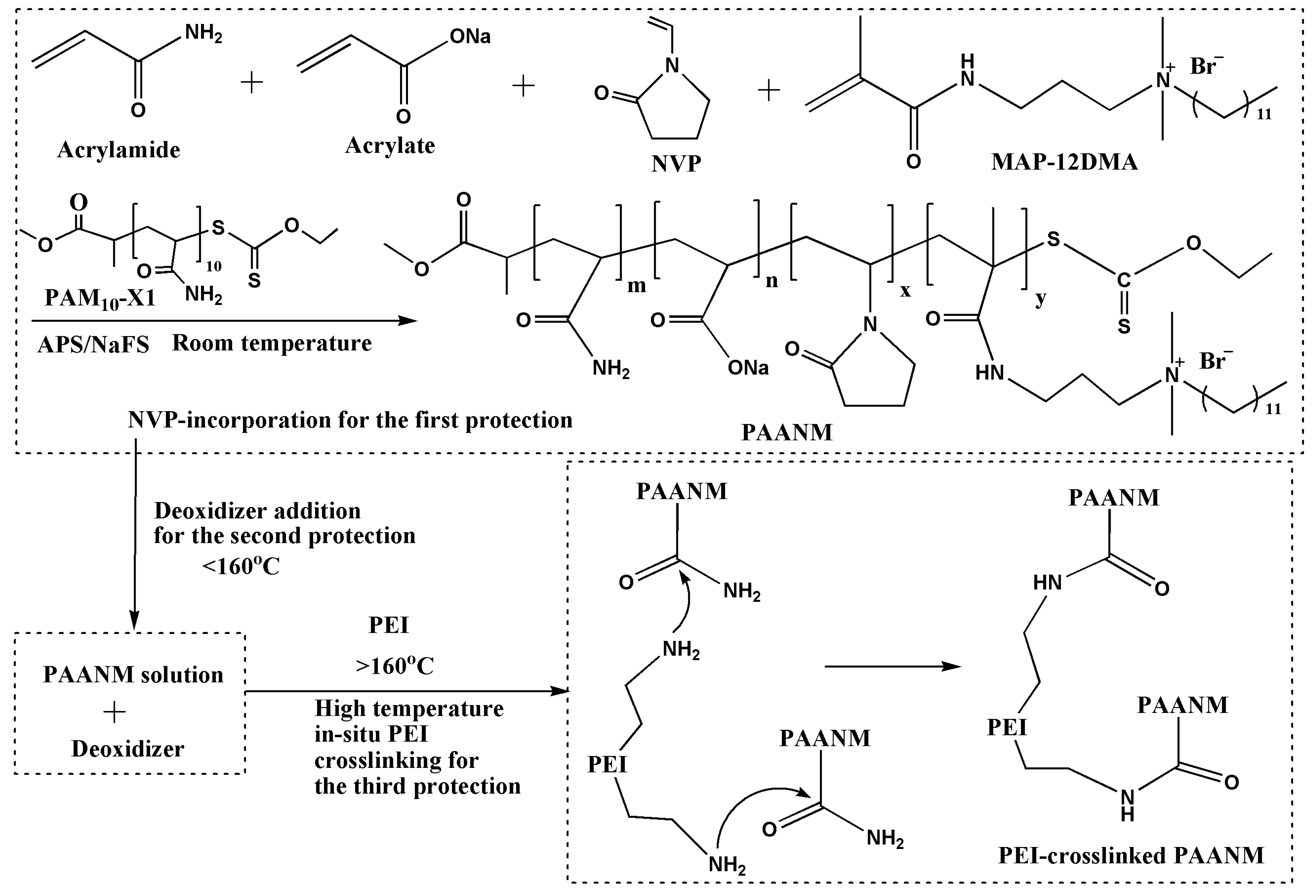


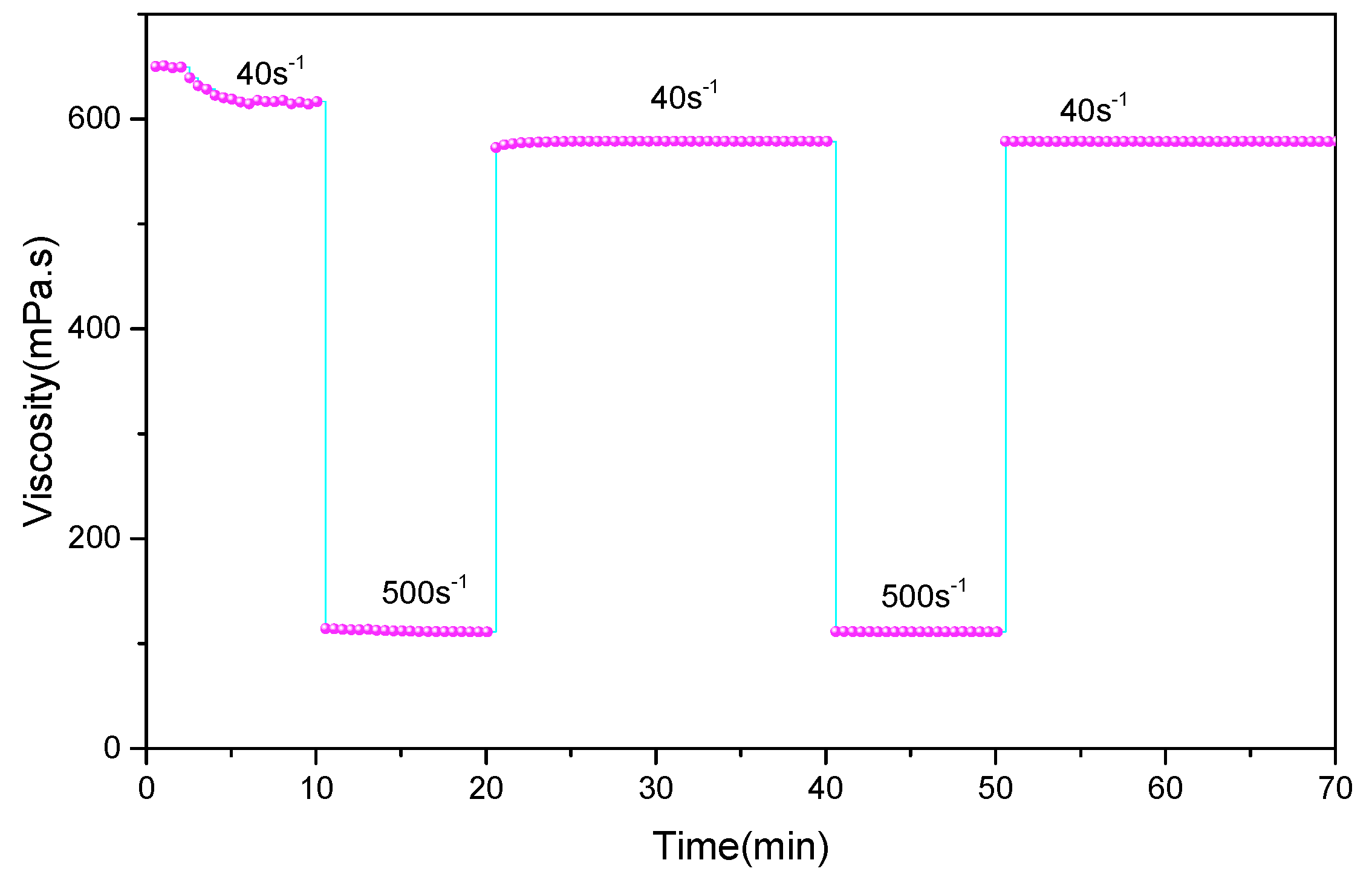
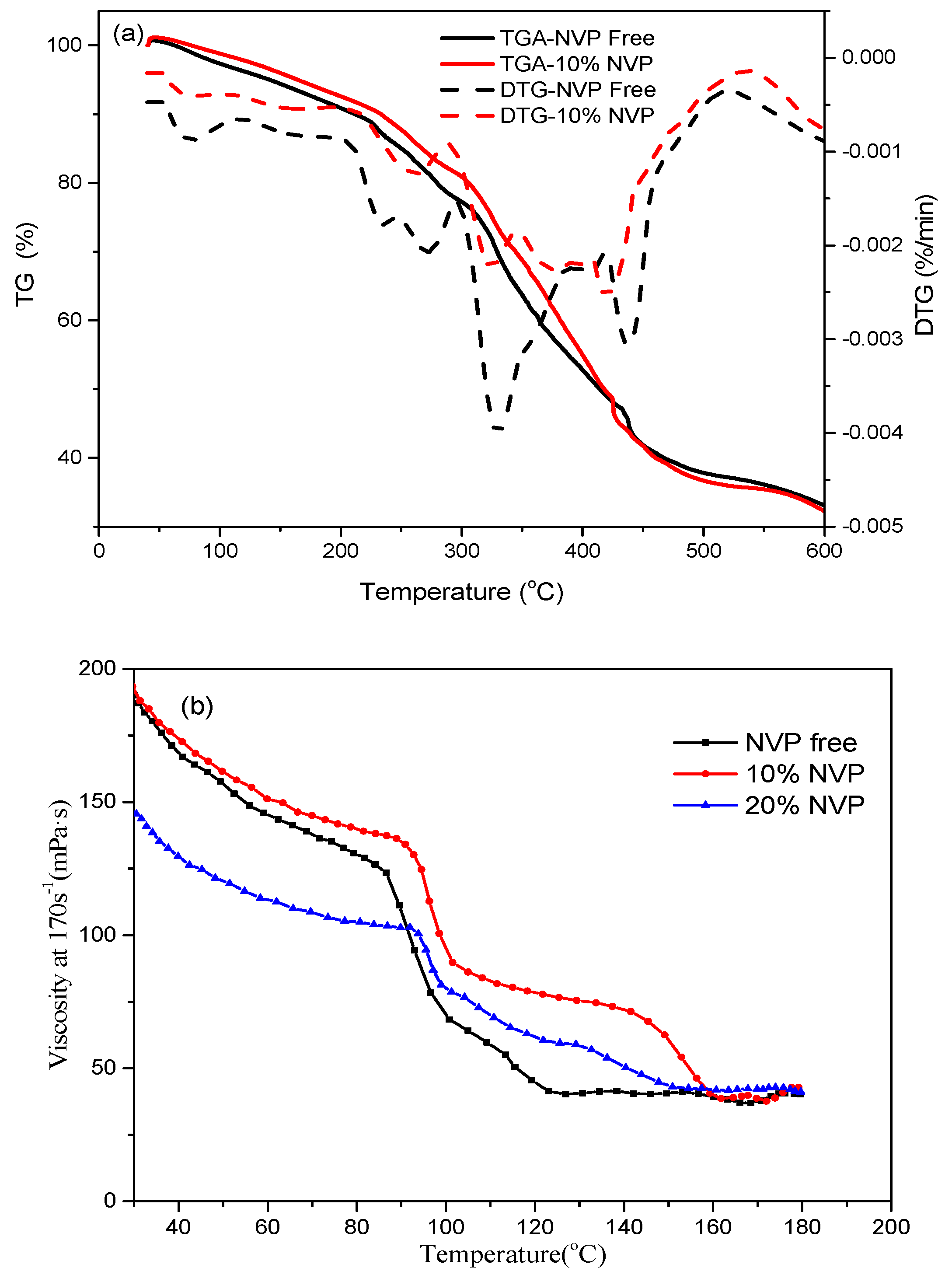
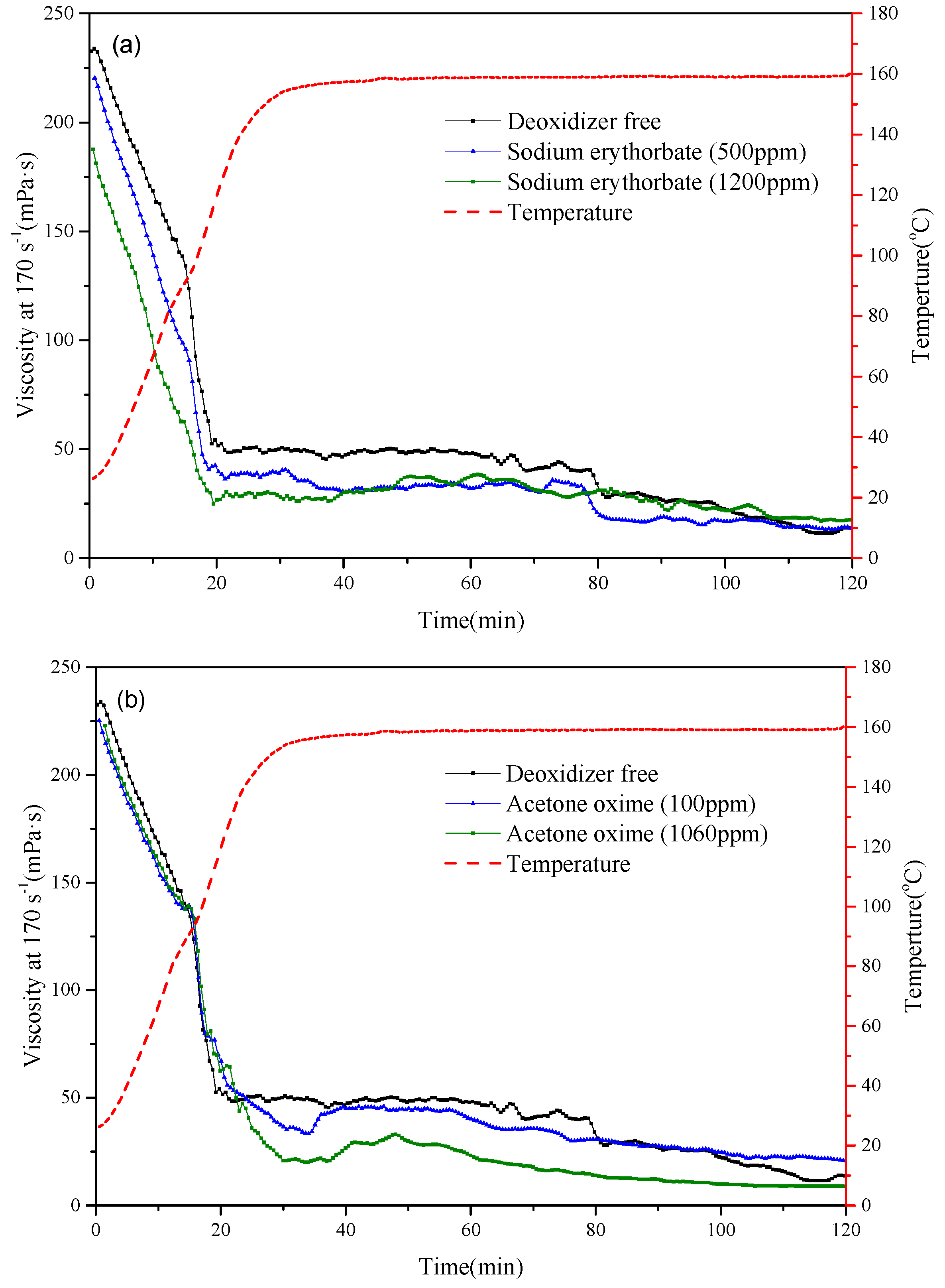
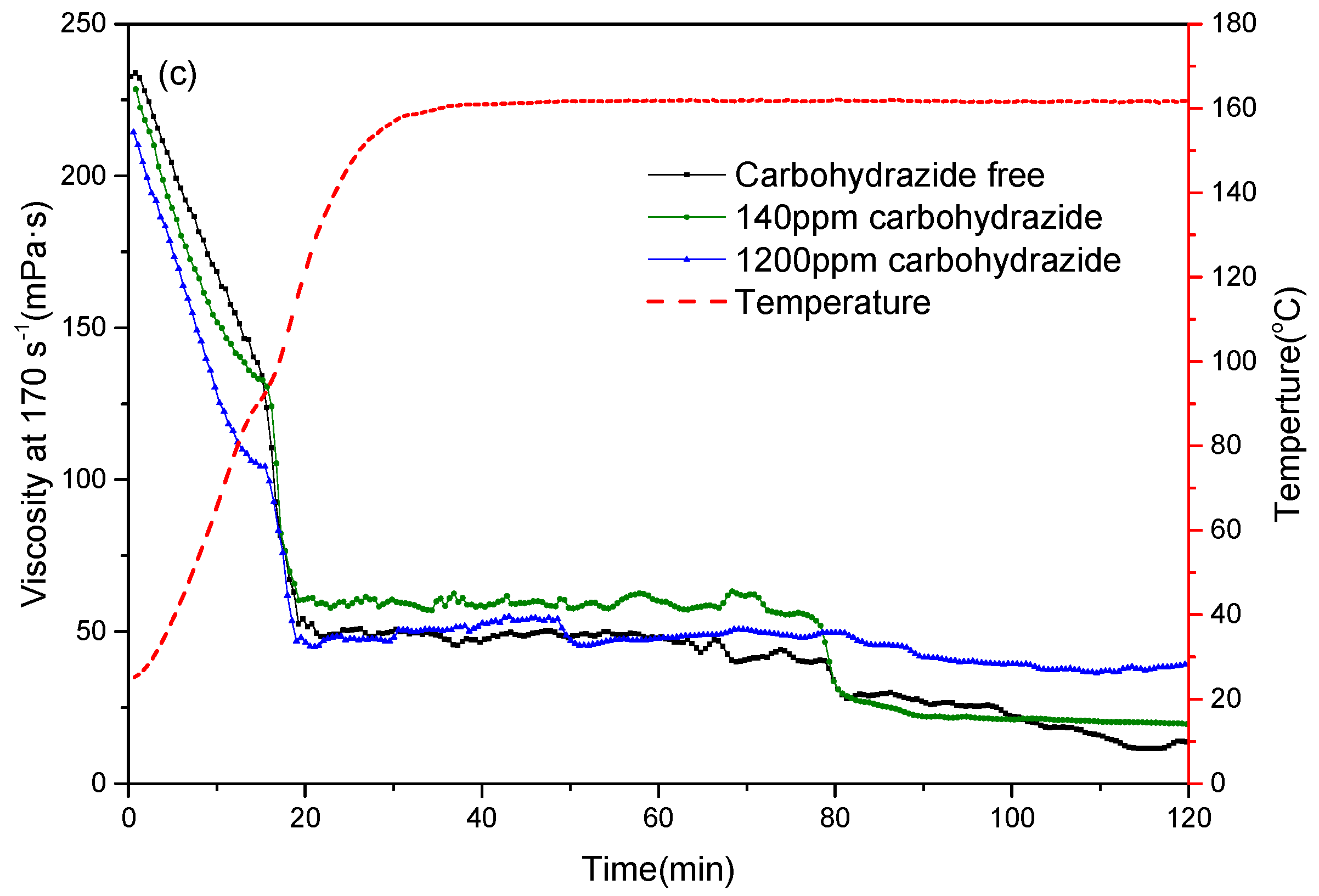
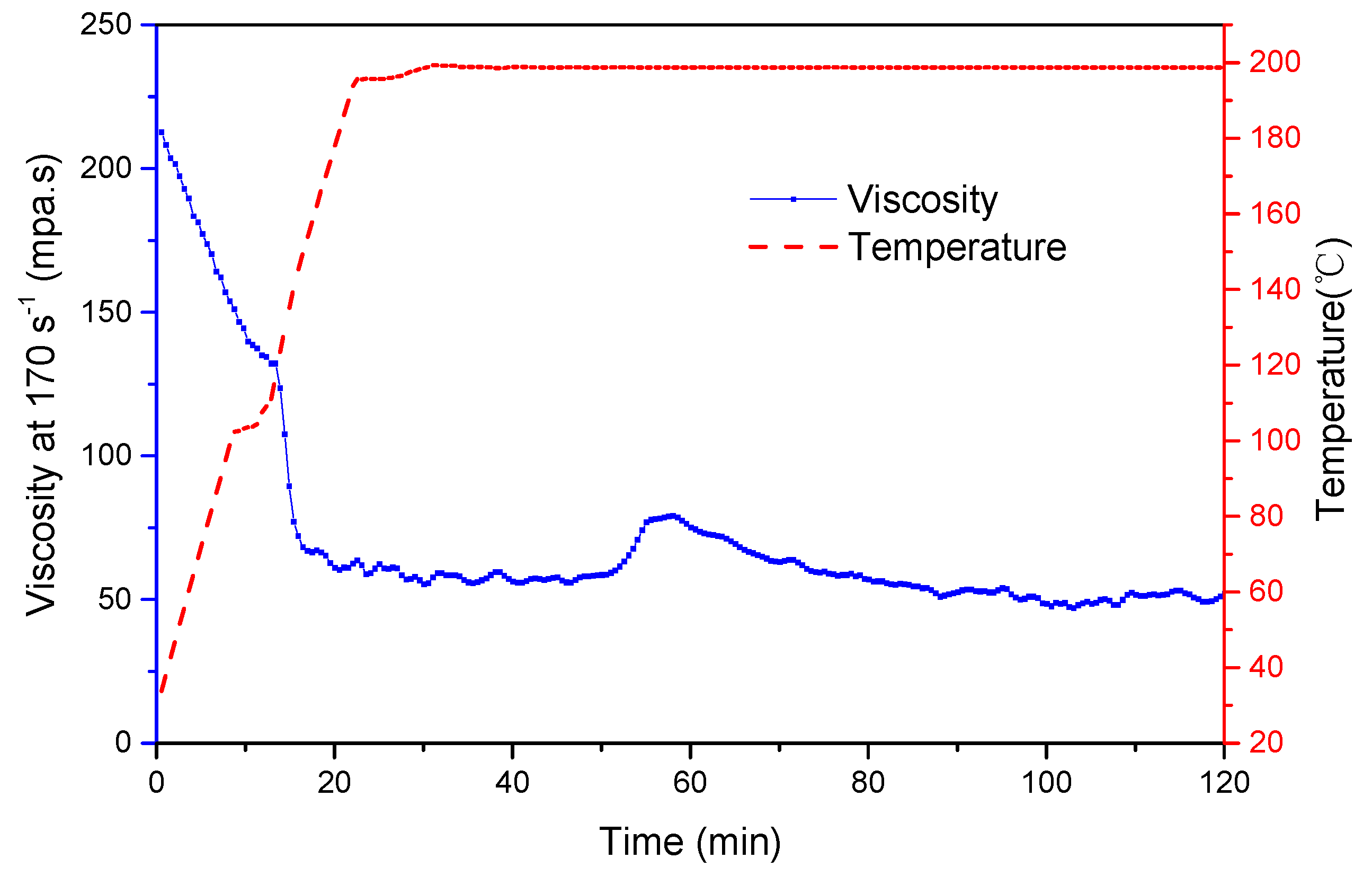
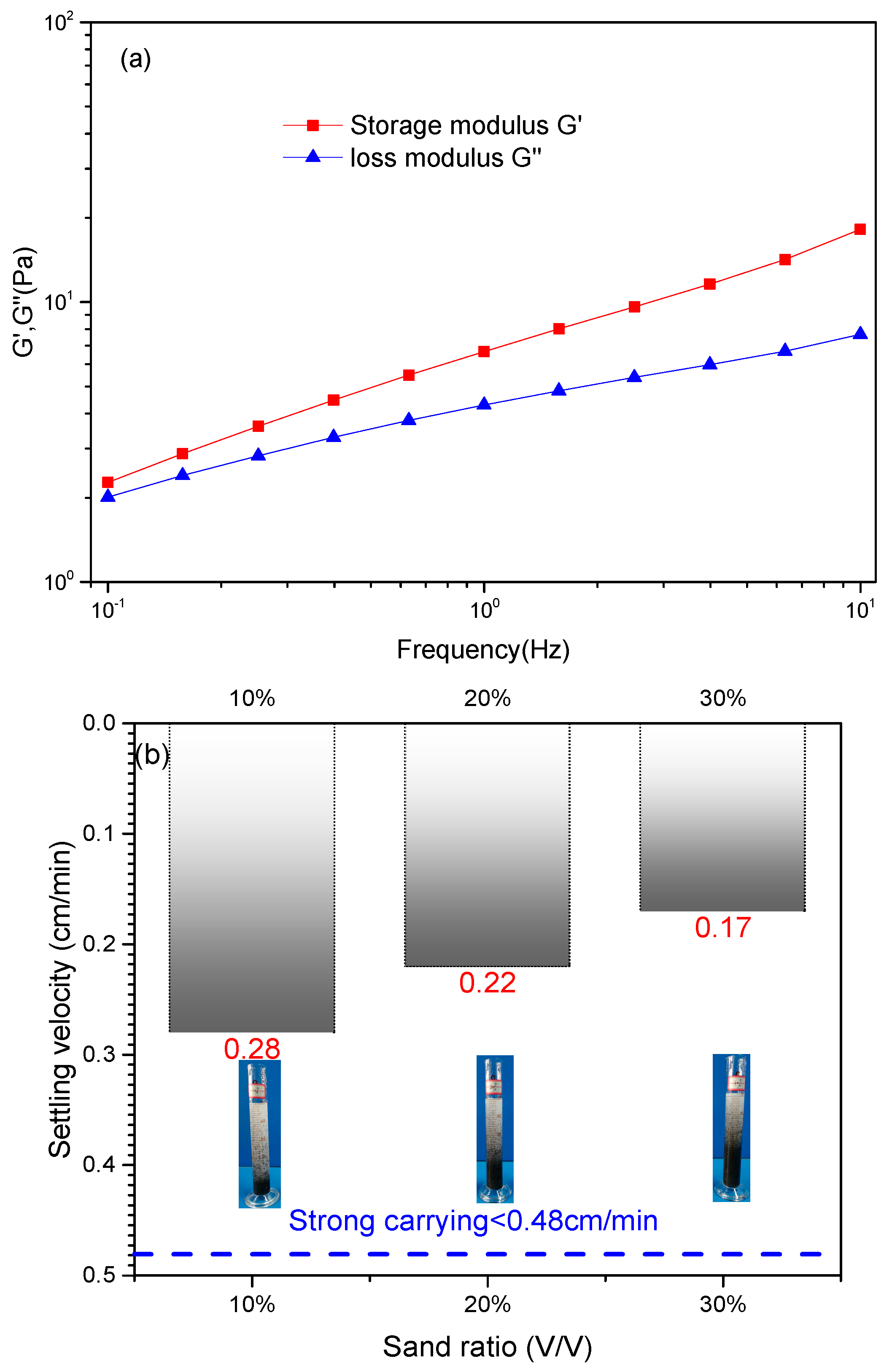

© 2019 by the authors. Licensee MDPI, Basel, Switzerland. This article is an open access article distributed under the terms and conditions of the Creative Commons Attribution (CC BY) license (http://creativecommons.org/licenses/by/4.0/).
Share and Cite
Yang, B.; Mao, J.; Zhao, J.; Shao, Y.; Zhang, Y.; Zhang, Z.; Lu, Q. Improving the Thermal Stability of Hydrophobic Associative Polymer Aqueous Solution Using a “Triple-Protection” Strategy. Polymers 2019, 11, 949. https://doi.org/10.3390/polym11060949
Yang B, Mao J, Zhao J, Shao Y, Zhang Y, Zhang Z, Lu Q. Improving the Thermal Stability of Hydrophobic Associative Polymer Aqueous Solution Using a “Triple-Protection” Strategy. Polymers. 2019; 11(6):949. https://doi.org/10.3390/polym11060949
Chicago/Turabian StyleYang, Bo, Jincheng Mao, Jinzhou Zhao, Yang Shao, Yang Zhang, Zhaoyang Zhang, and Qingye Lu. 2019. "Improving the Thermal Stability of Hydrophobic Associative Polymer Aqueous Solution Using a “Triple-Protection” Strategy" Polymers 11, no. 6: 949. https://doi.org/10.3390/polym11060949
APA StyleYang, B., Mao, J., Zhao, J., Shao, Y., Zhang, Y., Zhang, Z., & Lu, Q. (2019). Improving the Thermal Stability of Hydrophobic Associative Polymer Aqueous Solution Using a “Triple-Protection” Strategy. Polymers, 11(6), 949. https://doi.org/10.3390/polym11060949





